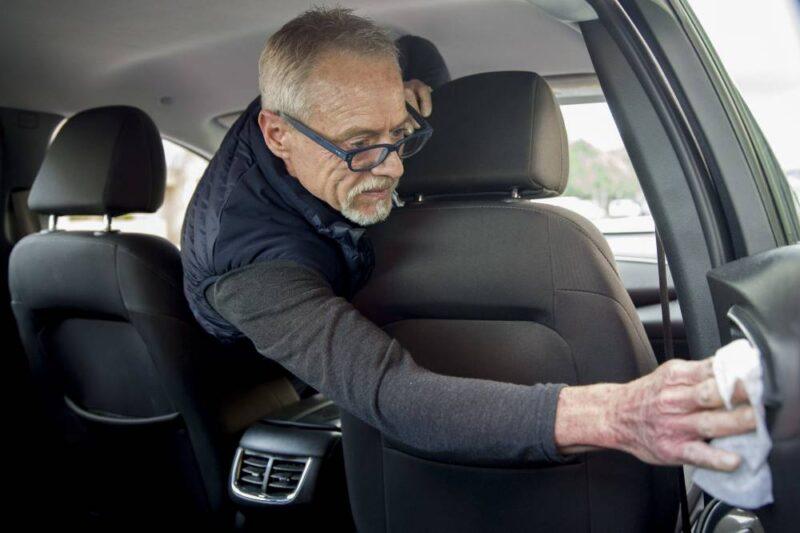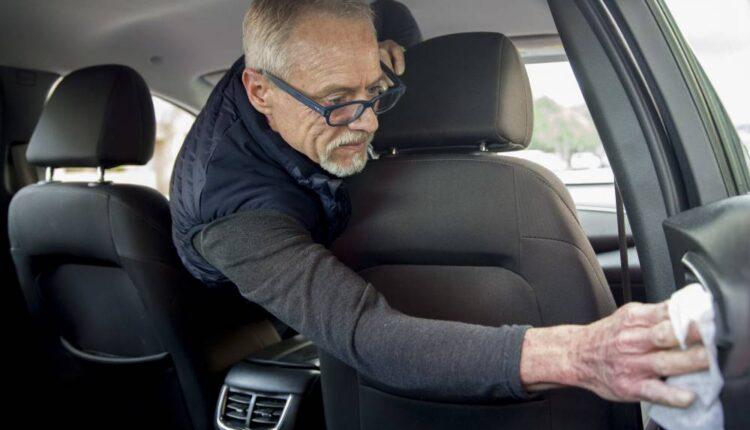
- Independent contractors, the self-employed and gig workers like Lyft and Uber drivers are eligible to collect unemployment benefits under the $2.2 trillion coronavirus relief law.
- The filing process is more involved for them relative to other workers and could increase the amount of time it takes to receive benefits.
Lyft driver Steven Smith uses a sanitizing wipe to disinfect his vehicle as he waits to get a call from a passenger in San Francisco, Calif. on Thursday, March 19, 2020. Smith and other Lyft drivers have seen a decline in ridership amidst the Bay Area's shelter-in-place in response to the global outbreak of the Coronavirus. (Jessica Christian/The San Francisco Chronicle via Getty Images)San Francisco Chronicle/Hearst Newspapers via Getty Images
Americans filing for unemployment benefits have been stymied by an overloaded system strained by record volume amid the coronavirus pandemic.
But the process has been especially fraught for self-employed workers and others, like those in the so-called gig economy, who are newly eligible to collect unemployment benefits.
While applying for unemployment benefits is generally a one-step process for traditional salaried workers receiving a W-2, it's become a two-step process for the self-employed, gig and other workers in most states, according to experts.
"It's a bit of a mess," said Stephen Wandner, a labor economist and senior fellow at the National Academy of Social Insurance.
"Congress was trying to do the right thing for this population," he said of the expanded pool of workers. "But there was no simple way to do it.
"This is a complex system and people will have great difficulty with it."
Expanded unemployment benefits
The $2.2 trillion coronavirus relief package enacted last month significantly expanded unemployment benefits.
The law raised weekly pay for jobless workers, increased the duration of those payments and extended benefits to previously ineligible workers.
The latter group includes self-employed individuals, gig workers like Lyft and Uber drivers, independent contractors, people seeking part-time employment and others whose work or ability to work has been impacted by Covid-19.
They can expect to get up to 39 weeks of unemployment benefits, the level of which varies drastically by state. At a minimum, they'll collect half their state's average weekly benefit. They'll also get an additional $600 a week through July.
The benefit expansion came as Americans began filing for unemployment in record numbers. Roughly 22 million people have filed claims in the four weeks through April 11.
However, the challenges of implementing the new law prevented states from accepting and processing applications from gig and other newly eligible workers.
Two-step process
Many states have since begun fielding applications from this group, but administrative hurdles have made the process roundabout and confusing, experts said.
That's because the coronavirus relief law pays benefits to them via something called Pandemic Unemployment Assistance. PUA isn't technically part of a state's unemployment insurance framework, according to experts.
Based on the way the coronavirus relief law is written, many (if not all) states will require this expanded group of workers to file for traditional unemployment insurance — similar to how a jobless W-2 worker would — and get denied for benefits, said Wandner, a former actuary with the U.S. Department of Labor.
After that denial, workers would be eligible to file for benefits under the new PUA system.
"I think every state will require that," Wandner said.
Robert Asaro-Angelo, the commissioner of the New Jersey Department of Labor and Workforce Development, alluded to that perhaps counterintuitive process.
"The first step is they have to be denied for unemployment first," he told NJ.com. "The law clearly says this is for individuals who would otherwise have been ineligible.
"No matter what, the first step is doing to be to go through the denial process."
More from Personal Finance
Scammers are defrauding unemployed Americans
How to prepare for unemployment
Some small businesses locked out of loan program
Not all states — Maryland, for example — are currently allowing workers to apply for PUA.
However, workers should take the proactive step of going through the unemployment-insurance-denial process now instead of waiting, said Wandner.
"The sooner you get the rejection, the sooner you'll be able to apply for Pandemic Unemployment Assistance," he said.
Ultimately, this could delay the amount of time it takes to start receiving payments. There's a silver lining: Many states will pay benefits retroactively to applicants' date of unemployment, so the first check should be larger to compensate for that delay, Wandner said.
Source: cnbc.com

